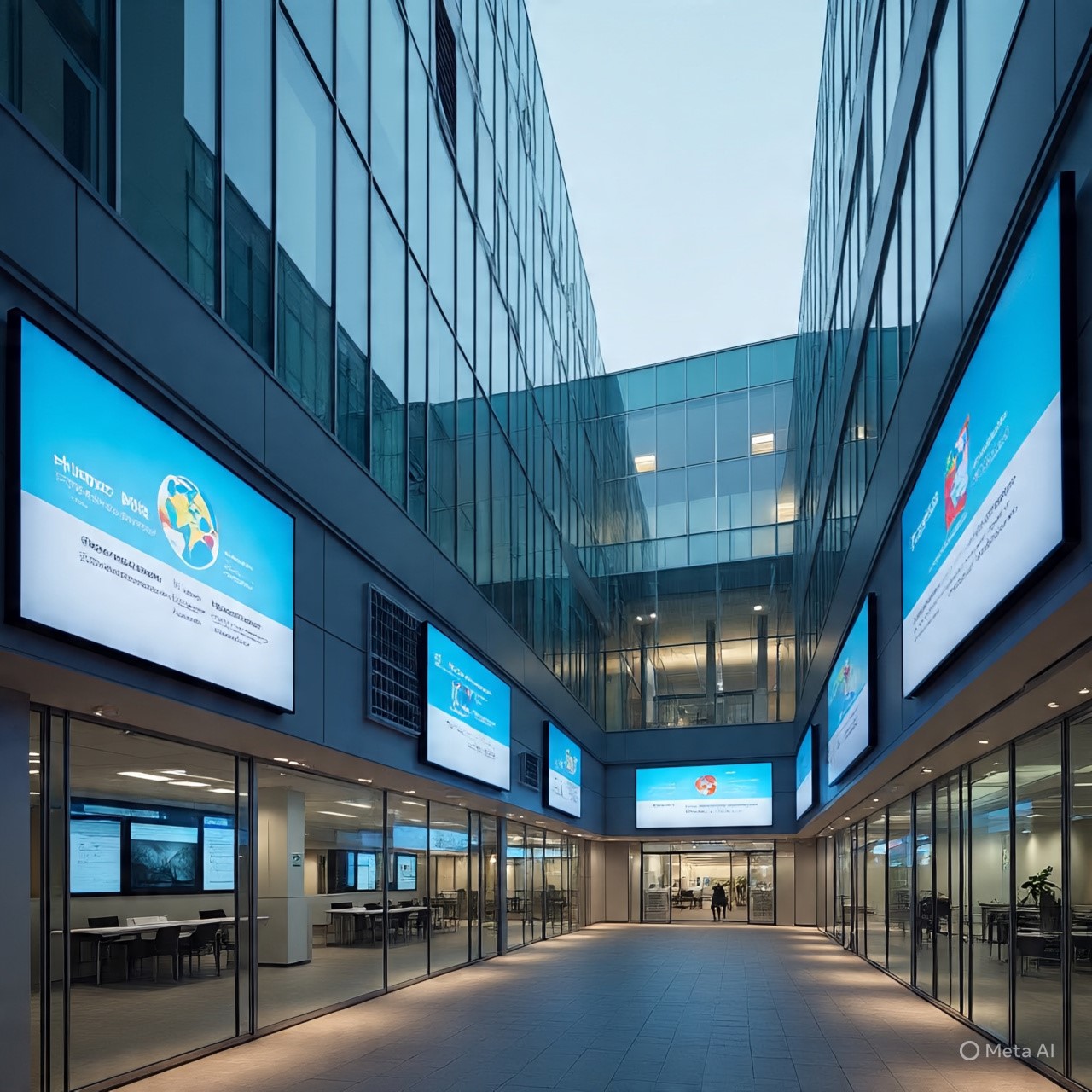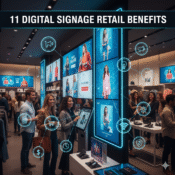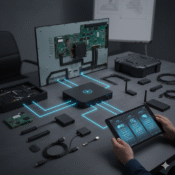
How Can Digital Signage Enhance Wayfinding?
In today’s fast-paced world, navigating complex environments like airports, hospitals, shopping malls, and large campuses can be overwhelming for visitors. Traditional static maps and signs often fall short in providing real-time, accessible, and personalized directions. This is where digital signage for wayfinding comes into play.
Digital signage combines dynamic displays, interactive kiosks, and smart integrations to transform how people find their way in unfamiliar spaces. By offering real-time, personalized, and accessible navigation, it not only improves user experience but also delivers operational benefits for organizations.
This article explores how digital signage enhances wayfinding, its key features, industry applications, challenges, and future trends.
What Is Digital Signage Wayfinding?
Definition and Features
Digital wayfinding signage uses digital displays, touchscreen kiosks, and interactive maps to guide people through complex spaces. Unlike static signs, it adapts to changing conditions and provides personalized, on-demand navigation support.
Digital vs. Static Wayfinding
- Static signage: Offers fixed information, often requiring redesign or replacement when facilities change.
- Digital signage: Delivers flexible, up-to-date, and interactive content that can be updated instantly.
Indoor and Outdoor Use Cases
- Indoor spaces: Airports, hospitals, retail centers, and corporate offices where people need to find departments, gates, or services.
- Outdoor spaces: University campuses, amusement parks, and city centers where interactive digital kiosks can provide maps and directions.
Why Is Digital Signage Important for Wayfinding?
Enhancing Navigation Accuracy
Digital signage provides precise, visual guidance to reduce navigation errors and confusion, ensuring smoother movement across large or complex spaces.
Improving User Experience
Dynamic, real-time navigation information enhances the visitor experience, reducing stress and frustration.
Operational Benefits for Facilities
Facility managers can update content instantly, saving time and reducing the need for staff involvement in guiding visitors.
Accessibility for All
Modern wayfinding signage is multilingual, ADA-compliant, and accessible, supporting diverse users with features like audio assistance and wheelchair-accessible routes.
How Digital Signage Enhances Wayfinding
Interactive Touchscreen Kiosks
Touch-enabled kiosks allow visitors to search for destinations, zoom into maps, and even receive printed or mobile directions.
- Personalization: Users can choose routes tailored to their needs (e.g., fastest, wheelchair-accessible).
- Accessibility features: Adjustable font sizes, voice guidance, and high-contrast modes help all users.
- Mobile integration: Directions can be transferred from kiosks to smartphones for on-the-go navigation.
Real-Time Information and Updates
Digital signage can provide live updates that static signs cannot.
- Instant alerts: For construction zones, route closures, or emergency exits.
- Dynamic changes: Reflecting event updates, traffic rerouting, or room availability.
Multilingual and Inclusive Communication
By offering language options, text-to-speech capabilities, and universal design principles, digital signage ensures inclusivity for a diverse user base.
Integration with Other Systems
Advanced digital wayfinding can integrate with:
- Building security systems: For emergency evacuation routes.
- Transportation schedules: Showing next bus, train, or shuttle times.
- Event management platforms: Updating visitors about conference schedules, room changes, or speaker sessions.
Benefits of Digital Signage for Wayfinding
- Clearer Guidance, Fewer Errors: Visitors reach their destinations without confusion.
- Enhanced User Satisfaction: A seamless experience improves perceptions of the facility.
- Time and Cost Savings: Less need for printed maps or staff assistance.
- Improved Accessibility and Inclusivity: Multilingual, ADA-compliant systems serve everyone equally.
- Operational Efficiency and Safety: Real-time updates and integrations enhance crowd flow and emergency management.
Practical Applications and Industry Use Cases
Airports
- Real-time gate changes, security line updates, and baggage claim directions.
- Optimized passenger flow to reduce congestion.
Healthcare Facilities
- Helping patients locate departments, labs, or rooms quickly.
- Reducing staff time spent giving directions.
Retail Centers
- Assisting shoppers in locating stores, restrooms, or services.
- Promoting sales, events, and personalized offers while guiding navigation.
Corporate Campuses
- Guiding employees and visitors across multi-building complexes.
- Displaying meeting room availability and office locations.
Event Venues
- Managing large crowds during concerts, exhibitions, or conferences.
- Displaying live schedule updates and venue maps.
Challenges and Considerations
While highly effective, organizations must address certain challenges when implementing digital signage wayfinding:
- Ensuring Data Accuracy: Outdated maps or incorrect directions can frustrate users.
- Privacy and Security: Interactive systems should safeguard user data.
- User Adoption: Training and user-friendly design are key to widespread use.
- Initial Costs: Hardware, software, and integration with legacy systems require upfront investment.
Future Trends in Digital Signage Wayfinding
The next generation of digital wayfinding is evolving rapidly with technological advancements:
- AI-Enhanced Personalization: Smart systems that suggest the best route based on user profile or real-time conditions.
- Augmented Reality (AR) Navigation: Smartphone-based AR overlays to guide users through facilities.
- Mobile and Remote Experiences: Extending wayfinding beyond kiosks to mobile apps and cloud platforms.
- Analytics-Driven Optimization: Collecting usage data to improve navigation design and facility planning.
Conclusion
Digital signage wayfinding is revolutionizing navigation across industries by delivering real-time, accessible, and user-friendly guidance. From airports and hospitals to retail centers and event venues, it enhances visitor experiences, reduces errors, and improves operational efficiency.
Organizations that adopt digital wayfinding solutions will benefit from smoother navigation, higher user satisfaction, and long-term cost savings. As AI, AR, and mobile integrations expand, the future promises even smarter and more seamless wayfinding systems.
FAQs
How does digital signage improve wayfinding accuracy?
By providing real-time, interactive maps and alerts, digital signage ensures users take the most accurate and efficient routes.
Can digital signage wayfinding systems be customized for different facilities?
Yes, they can be tailored with unique maps, content, and integrations based on the facility’s needs.
What accessibility features are available in digital signage for wayfinding?
Common features include multilingual support, audio guidance, adjustable text sizes, and wheelchair-accessible route options.
Can digital signage wayfinding integrate with mobile apps?
Yes, many systems allow users to transfer directions from kiosks to mobile devices for continuous navigation support.



